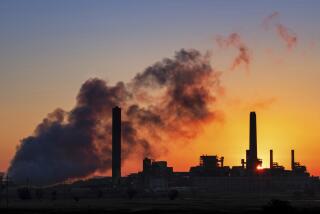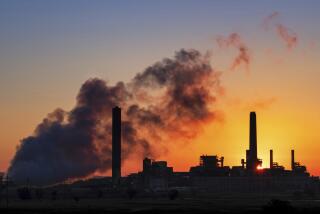EPA Rejects Panel Advice on Pollutant : Says It Will Not Ask for Stronger Controls on Sulfur Dioxide
- Share via
Rejecting the advice of its panel of expert scientific advisers, the Environmental Protection Agency today declined to tighten restrictions on sulfur dioxide, a major pollutant primarily associated with coal-burning power plants.
Last year, EPA’s Clean Air Scientific Advisory Committee had strongly recommended tighter restrictions on the pollutant, saying that current rules on sulfur dioxide allowed serious health problems for about 200,000 asthmatics living near power plants.
Today’s decision, made after nearly a decade of debate within the agency, brought howls of protest from environmental groups, who accused the agency of sacrificing controls on acid rain and the health of asthmatics, whose condition is worsened by the pollutant, to placate the utility industry.
‘Utilities Come First’
“There is a whole slew of evidence” accumulated since 1980 that many asthmatics are not being protected by current standards, said David Doniger of the Natural Resources Defense Council, adding that “for this Administration the wishes of the utility industry always come first.”
Bob Yuhnke of the Environmental Defense Fund said his organization will try to get a court to order a short-term standard established.
At the Edison Electric Institute, the principal trade association for utilities, spokeswoman Susan Roth said EPA’s decision “reflects a careful weighing of all the scientific evidence.”
Concentrations Reduced
She said current standards reduced average sulfur dioxide concentrations by 37% between 1977 and 1986. The institute has said a stringent short-term standard could be as costly as an acid rain control program, perhaps $5 billion a year.
According to EPA’s announcement, new studies have found “measurable changes in respiratory function and symptomatic effects--shortness of breath, wheezing, coughing--in asthmatics exposed for short periods, five to 10 minutes up to one hour, to 0.4 parts per million of sulfur dioxide or more.”
But it said “these responses occurred predominantly in subjects who were exercising and not using preventive medication at the time.”
It added that the effects “appear to be transient and reversible and, at lower concentrations, are similar to those most asthmatics typically experience from exercise or other stimuli, for example, cold air.”
More to Read
Sign up for Essential California
The most important California stories and recommendations in your inbox every morning.
You may occasionally receive promotional content from the Los Angeles Times.










